Like intrepid explorers forging new territory, American Eskimo Dogs trekked from their Nordic homeland across oceans to reach America’s shores. And much like adventurers adapting to uncharted lands, these clever canines adjusted to circus spotlights and family living rooms with their signature gusto. You can delveYes! They are known for their thick double coat, which shed heavily twice yearly. into the captivating world of this striking breed.
Learn the origins of their snowy coats and pointy ears. Discover their dietary needs, grooming demands, and exercise requirements. We’ll also explore their trainability, lifespan and health issues. Join us on an exciting expedition through history to uncover what makes American Eskimo Dogs such agile companions!
Table of Contents
- 1 American Eskimo Dogs: History and Traits
- 2 Nutrition and Exercise Needs for Eskimos
- 3 Grooming and Health Concerns in Eskimos
- 4 Training and Socializing Your Eskimo Puppy
- 5 Choosing Your Eskimo: Breeders vs. Adoption
- 6 Aging and Family Life with Eskimos
- 6.1 How long does an American Eskimo dog live?
- 6.2 Are American Eskimo dogs good family pets?
- 6.3 What kind of health issues do American Eskimo dogs have?
- 6.4 How much exercise does an American Eskimo dog need?
- 6.5 Should I adopt or buy from a breeder?
- 6.6 How hard is it to train an American Eskimo puppy?
- 6.7 Do American Eskimos shed a lot?
- 6.8
- 7 Related posts:
- 8 American Eskimo Dog Colors: Complete Guide
- 9 American Eskimo Dog: Breed Facts & Care
- 10 American Eskimo Dog Shedding: What to Expect!
- 11 Unveiling the American Eskimo Dog Temperament: A Detailed Guide
American Eskimo Dogs: History and Traits
Origin and Historical Background
The American Eskimo dog breed, often called spitz dogs, traces its roots back to Nordic breeds. Contrary to their name, these dogs are not from Alaska but from Germany. Known for their distinctive fluffy white coats, they were bred by the AKC for their agility and intelligence.
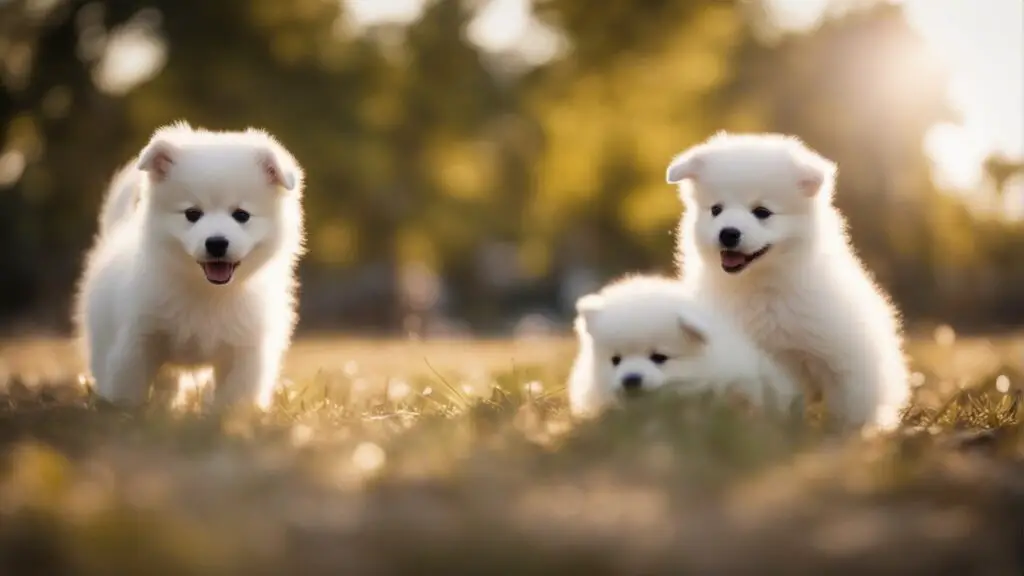
Unique Physical Traits
American Eskimo puppies grow into medium-sized dogs with a striking appearance. Key physical traits include:
- Fluffy white fur
- Pointy ears typical of spitz breeds
- Bright blue or brown eyes
Behavioral Tendencies
American Eskimos exhibit several common behavioral tendencies:
- They’re brilliant.
- They have a protective instinct.
- They can be somewhat reserved with strangers.
These characteristics make them excellent watchdogs, but require consistent training from puppyhood.
Role of Genetics
Genetics plays a significant role in shaping these traits in this dog breed. The spitz genes contribute to their physical features, like the thick coat and pointy ears, while influencing their behavioral tendency towards alertness and protectiveness.

Nutrition and Exercise Needs for Eskimos
A balanced diet is vital to an American Eskimo puppy’s growth. They need specific nutrients to stay healthy.
- Protein: For muscle development, aim for 22% in puppy food.
- Fat: Provides energy. Look for a minimum of 8%.
Exercise is also crucial. An active breed needs enough training to burn energy and maintain fitness. A good idea is to check their activity level regularly.
- Walks: Two short walks daily
- Playtime: Fetch or agility games can keep them engaged
Nutrition and exercise directly impact their lifespan. An unhealthy diet or lack of activity can lead to obesity or other health issues. So, it’s worth the time and effort to search for the right food and ensure they get enough exercise.
Remember, every puppy is unique. Their needs may vary based on size – larger pups might require more food and exercise than smaller ones. The general rule of thumb:
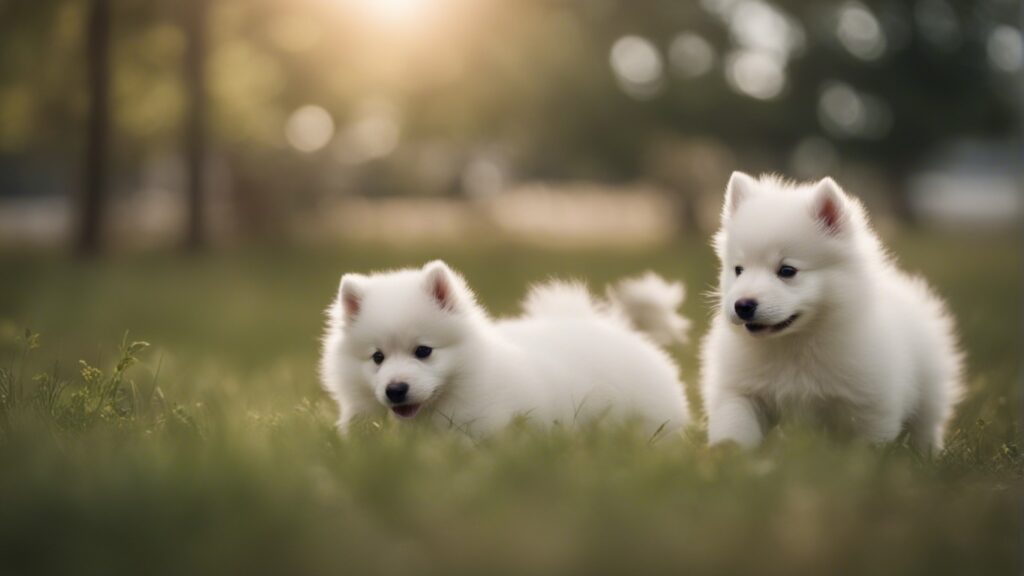
- Puppies weighing less than 10 pounds need about 1/2 cup of dry food per day
- Add another 1/4 cup for each additional 5 pounds
And don’t forget about the heat! Eskies have a thick double coat that keeps them warm but makes them prone to overheating during intense activity.
Grooming and Health Concerns in Eskimos
Essential Grooming Practices
American Eskimo puppies have a thick coat that needs regular care. Brush their coat at least twice weekly to prevent matting and skin issues. Don’t forget the dental care; brushing their teeth regularly helps avoid oral health problems.
Common Health Issues
Like any breed, American Eskimo puppies can face specific health problems:
- Hip Dysplasia
- Progressive Retinal Atrophy (PRA)
- Legg-Calve-Perthes Disease
These are common but not exclusive to this breed. Therefore, it’s crucial to get health clearances for your puppy.
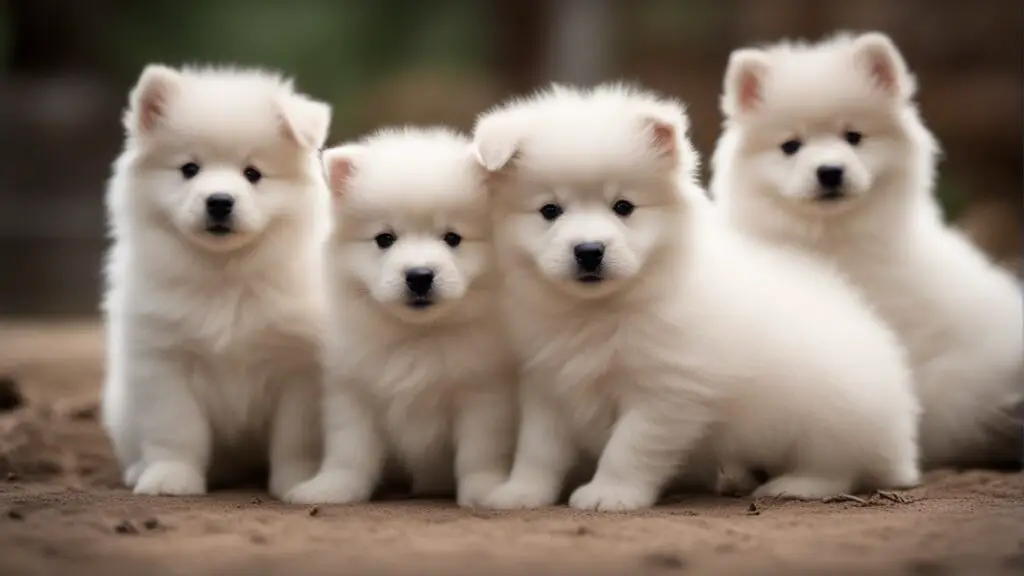
Regular Vet Check-ups
Ensure you take your American Eskimo puppy for regular vet check-ups. Early detection of any potential health problems is critical. Your vet can guide you on the best care practices for your pup’s well-being.
Preventive Measures
To keep your American Eskimo healthy, consider these preventive measures:
- Feed them a balanced diet.
- Ensure they get enough exercise.
- Regular grooming sessions.
- Keep up with vaccinations and deworming schedules.
Every dog is unique and might need different care strategies based on their needs and circumstances. Always consult with your vet if in doubt about what’s best for your furry friend’s health.
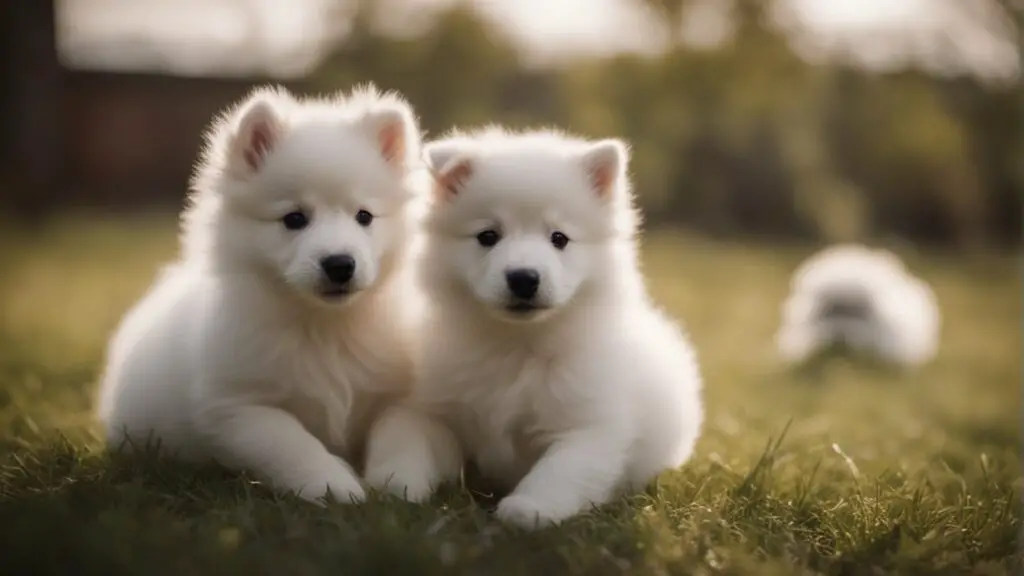
Training and Socializing Your Eskimo Puppy
Early obedience training sessions are a must for American Eskimo puppies. These furballs are smart, so dog owners can use techniques that match their intelligence level.
- Obedience Training: Start with basic commands like ‘sit’’ ‘stay’’ and ‘come’’ Use chew toys as rewards.
- Dog Sports: Engage them in dog sports. Their agility makes them great at it.
Socialization from a young age is crucial. It influences their temperament significantly. A well-socialized Eskie is friendly and confident.
- Kennel or Farm Dog: Introduce your puppy to different environments like a kennel or farm.
- Watchdog Training: Teach them watchdog skills early on to boost confidence.
- Rescue Groups: Get involved in rescue groups where they meet other dogs.
Training and socialization turn an American Eskimo puppy into a well-behaved adult dog, ready for any situation!
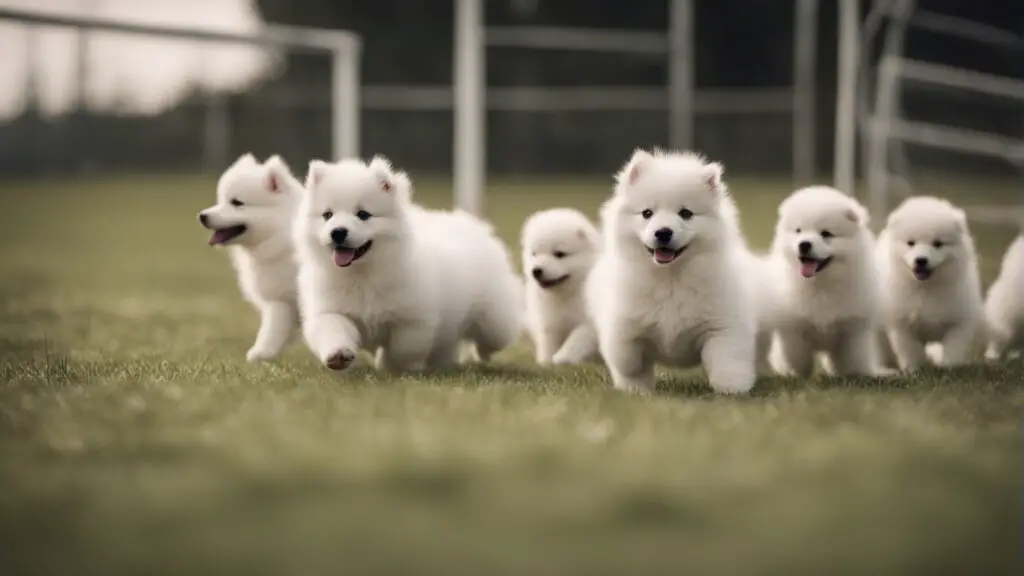
Choosing Your Eskimo: Breeders vs. Adoption
Factors to Consider
Deciding between breeders or adoption? Here’s what to consider:
- Breed: American Eskimo puppies are specific breeds. Breeders can guarantee this, but adoptions might not.
- Age: Puppies from breeders. Shelters of all ages.
Ethical Considerations
Dog breeding isn’t always ethical. Some breeders prioritize profit over animal welfare. It’s crucial to find reputable sources for your American Eskimo puppy.
Adopting an Adult Dog
Adopting an adult dog comes with its own set of benefits and challenges:
- Benefits:
- Already trained
- Personality is known
- Challenges:
- May have health issues
- Behavioral problems
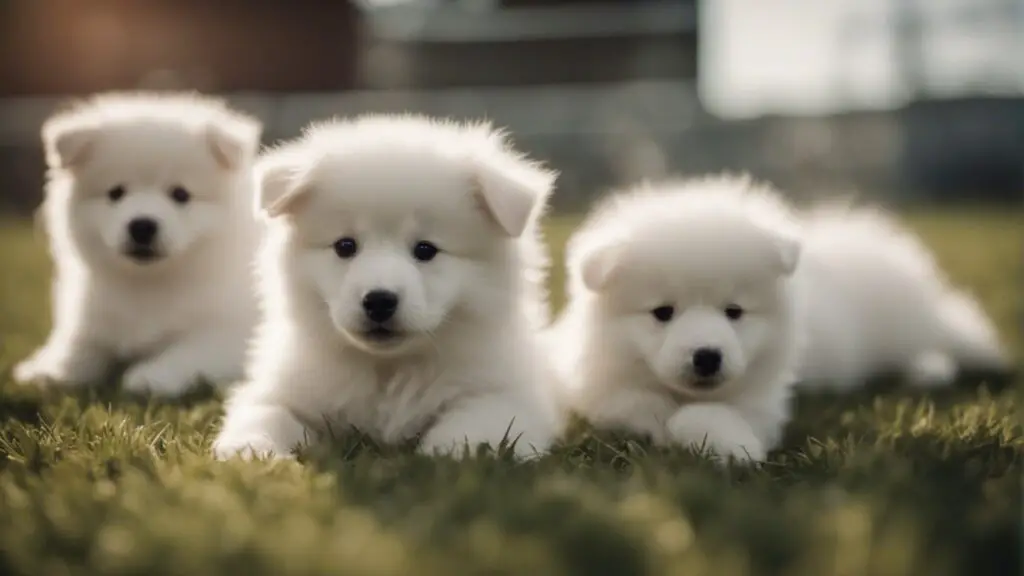
Finding Reputable Sources
Whether adopting or buying, it’s essential to do your homework:
- Research the source thoroughly.
- Ask for references or reviews.
- Visit the place before making a decision.
Remember, choosing between breeders and adoption depends on personal circumstances and preferences. Always consider what is best for you and the dog!
Aging and Family Life with Eskimos
Your American Eskimo will grow old, just like us. It’s a bittersweet journey with plenty of tail wags and wet-nose kisses. These fluff balls are more than just pets; they’re family. So, how do you make their golden years as comfortable as possible? It’s all about maintaining a healthy lifestyle—proper nutrition, regular exercise, and lots of love! Remember our chat on grooming and health concerns? Keep those in mind, too.
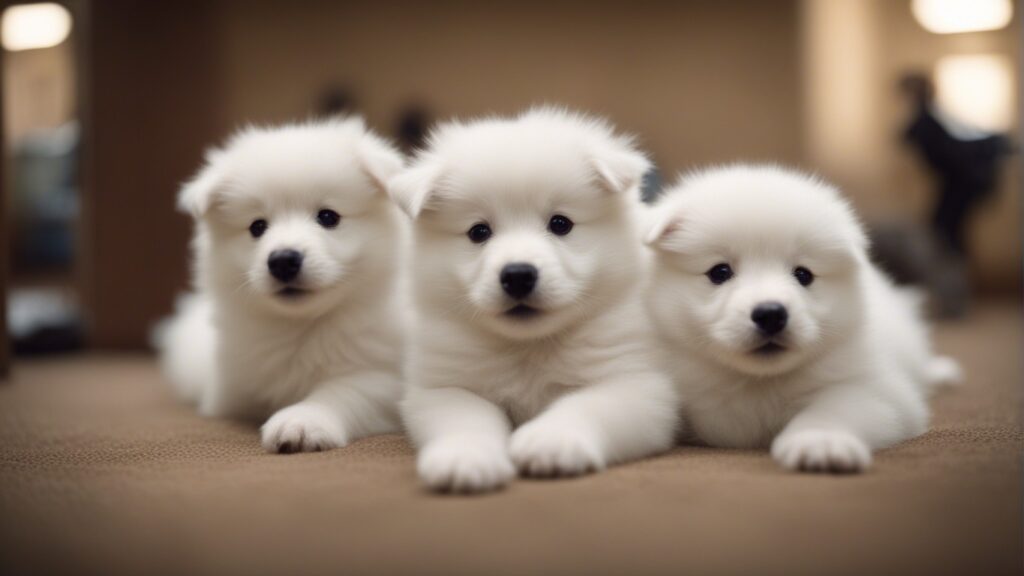
From circus performer to devoted family pet, the American Eskimo Dog has played many roles with style and vigor. Their journey from Nordic regions to American households is a testament to their adaptability. But those stunning white coats come at a grooming cost. Provide proper nutrition, training, socialization, and healthcare; these energetic dogs will repay you with years of friendship. They flourish when given an active lifestyle and lots of attention. Shower them with love, keep up with their demands, and your Eskimo companion will fill your days with loyalty and joy. So brace yourself for an exhilarating ride when you welcome an American Eskimo Dog into your home!
How long does an American Eskimo dog live?
American Eskimo dogs typically live between 12 to 15 years.
Are American Eskimo dogs good family pets?
Absolutely! They are known for their friendly nature and loyalty towards their families.
What kind of health issues do American Eskimo dogs have?
Like any breed, they can be prone to certain genetic conditions such as hip dysplasia and progressive retinal atrophy (PRA).
How much exercise does an American Eskimo dog need?
These energetic pups require at least an hour of exercise daily.
Should I adopt or buy from a breeder?
Both options have their pros and cons. Adoption often gives a second chance to a deserving pet, while buying from reputable breeders assures pedigree lineage.
How hard is it to train an American Eskimo puppy?
Training your eskies can be pretty manageable with positive reinforcement methods and consistency.
Do American Eskimos shed a lot?
Yes! They are known for their thick double coat, which shed heavily twice yearly.